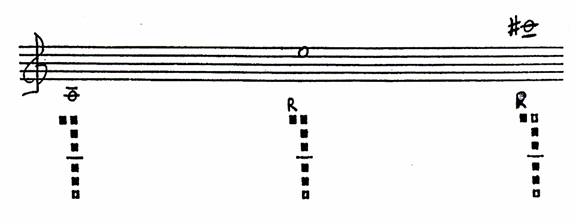| The Clarinet of the Twenty-First Century - E. Michael Richards |
CHAPTER 1 - Evolution & Design
General Acoustic Principles of the Clarinet
The acoustical system which woodwind instruments are built on consists of a "mixed" system. 39 One part of this system consists of the tones in the lower register, which are all fundamentals; the other parts are the higher registers which are derived from partials of the harmonic series of these fundamentals (see diagrams in Example #3). 40 These upper tones consist of wavelengths that are integral fractions of their particular fundamental (ie. 1/2, 1/3, 1/4 etc.). An example on the clarinet can be drawn from the low written A (see Example #3, left), which acts as a fundamental.
Example #3:

By adding an open register key to this fingering, E is produced (Example #3, middle); a twelfth higher than A, or its 3rd partial (the open register key shortens the air column to 1/3 the length of A). If one alters the E fingering by lifting the first finger of the left hand, a new vent is created (shortening the air column again); this produces the pitch C-sharp, the 5th partial of A (Example #3, right). Since the pitches in the harmonic series become closer together as they get further away from the fundamental, it makes sense that the clarinet offers so many alternate fingerings for pitches in its altissimo register; pitches in this register may be derived from the partials of several different fundamentals (Example #4).
Example #4

It also explains why consistent intonation is so difficult to achieve in this register, primarily since one is so far removed from the fundamental.
If one compares the basic acoustical systems of the clarinet to the other woodwinds, one strong difference appears. The register key on the clarinet produces a register a twelfth higher; on the other woodwinds, this difference is only an octave. Acousticians tell us that this is because the clarinet operates as a cylindrical pipe, closed at one end (the flute is a cylindrical pipe open at both ends, and the oboe and bassoon are tapered conical pipes, closed at one end). It is interesting that the clarinet sounds an octave lower than the flute or oboe even though it utilizes an equivalent pipe length. This is because the lowest frequency of sound vibration that will cause it to resonate has a wavelength four times the length of the pipe. A cylindrical pipe closed at one end should leave only odd numbered partials available (3, 5, 7, etc.) for higher register fingerings; thus, a tone on the clarinet contains only odd-numbered partials. 41 This appears to be so from our example, but spectrum analyses of steady clarinet tones suggest the appearances of even-numbered partials having amplitudes comparable to or even greater than those of neighboring odd ones on certain fundamentals, and thus presents us with contradictory evidence. 42
The acoustician John Backus offers a logical explanation in an article entitled, "Resonance Frequencies of the Clarinet." 43
The clarinet actually differs considerably from the simple cylinder. The wedge shape of the mouthpiece cavity at the reed end, the covered tone holes, the flare at the bell end of the instrument, and the open tone-hole portion of the column all produce deviations from the simple cylinder geometry. Hence we should not expect the resonance frequencies for the clarinet to be precisely integral odd multiples of a fundamental frequency. 44
Backus found that the clarinet has a number of resonances of which the first three have frequencies which match, reasonably well, the first three harmonics of the internal standing wave. These harmonics are therefore strong, and the second harmonic absent. As the effective length of the instrument is shortened by opening side holes, the number of significant resonances decreases, and with it the number of harmonics. For the highest note in the low register (Bb 4), there are only two strong resonances and hence two strong harmonics, the first and third. The second harmonic is absent; and above the third harmonic, the others are present in approximately equal amounts. In this second register, the resonances are completely out of tune with the harmonics so that both odd and even harmonics are present, including the second. None of the harmonic frequencies in the clarion register (D4-G4) match the resonances. In fact, the even harmonics are about as important as the odd ones; the second harmonic, which is completely lacking in the lower register, is quite prominent in the clarion register. 45
This information suggests reasons why the throat tones do not match colors with the surrounding registers, as well as why the chalumeau and clarion registers sound so different in timbre. The acousticians McGinnis, Hawkins, and Sher also present us with some provocative disclosures about clarinet timbre, especially in the clarion and altissimo registers. 46 They have found that the second and fourth harmonic (particularly the fourth) are much stronger in the clarion than in the chalumeau register. The fundamental is also slightly more intense in the clarion. Changes in intensity, however, cause less variation in the clarion, especially between F and MF. These qualities (a variety of lower partials) in this register suggest why the clarion has often been compared to the human voice. The phenomena of stable timbres despite changing intensities is also found in the altissimo register. The fundamental in the altissimo register, though, is weaker than in other registers, while the second partial is much stronger. The reason for this predominance may be related to the two vents (register key plus left-hand first-finger) that are needed to produce the highest register. Thus, an explanation is afforded for why the timbre of the altissimo register is brighter sounding than the clarion.
for information on how to see more about the evolution of the Boehm clarinet, click here
|
||